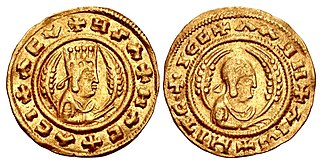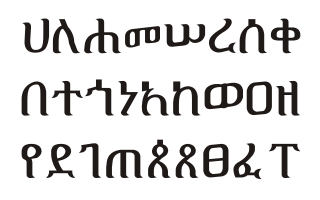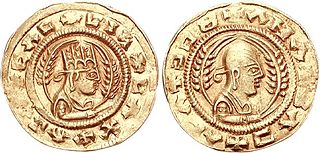Related Research Articles

The Ethiopian Orthodox Tewahedo Church is the largest of the Oriental Orthodox Churches. One of the few Christian churches in sub-Saharan Africa originating before European colonization of the continent, the Ethiopian Orthodox Tewahedo Church dates back to the acceptance of Christianity by the Kingdom of Aksum in 330, and has between 36 million and 49.8 million adherents in Ethiopia. It is a founding member of the World Council of Churches. The Ethiopian Orthodox Tewahedo Church is in communion with the other Oriental Orthodox churches.

Frumentius was a Phoenician Christian missionary and the first bishop of Axum who brought Christianity to the Kingdom of Aksum. He is sometimes known by other names, such as Abuna and Aba Salama.

Pope Cyril VI of Alexandria also called Abba Kyrillos VI, Coptic: Ⲡⲁⲡⲁ Ⲁⲃⲃⲁ Ⲕⲩⲣⲓⲗⲗⲟⲥ ⲋ̅ ;, was the 116th Pope of Alexandria and Patriarch of the See of St. Mark from 10 May 1959 to his death.

The emperor of Ethiopia, also known as the Atse, was the hereditary ruler of the Ethiopian Empire, from at least the 13th century until the abolition of the monarchy in 1975. The emperor was the head of state and head of government, with ultimate executive, judicial and legislative power in that country. A National Geographic article from 1965 called imperial Ethiopia "nominally a constitutional monarchy; in fact [it was] a benevolent autocracy".

Ezana was ruler of the Kingdom of Aksum, an ancient kingdom located in what is now Eritrea and Ethiopia.. One of the best documented rulers of Aksum, Ezana is important as the first king of that country to embrace Christianity and to make it the official religion.

The Zagwe dynasty was an Agaw medieval dynasty that ruled the northern parts of Ethiopia and Eritrea, after the historical name of the Lasta province. Centered at Roha, it ruled large parts of the territory from approximately 900 to 1270 CE, when the last Zagwe King Za-Ilmaknun was killed in battle by the forces of the Amhara King Yekuno Amlak. The name of the dynasty is thought to derive from the ancient Ge'ez phrase Ze-Agaw, meaning "of the Agaw", in reference to the Mara Tekle Haymanot, the founder of the dynasty. Zagwe's best-known King was Gebre Mesqel Lalibela, who is credited with having constructed the rock-hewn monolithic churches of Lalibela.

Menas or Minas, throne name Admas Sagad I, was Emperor of Ethiopia from 1559 until his death in 1563, and a member of the Solomonic dynasty. He was a brother of Gelawdewos and the son of Emperor Dawit II

Zara Yaqob was Emperor of Ethiopia, and a member of the Solomonic dynasty who ruled under the regnal name Kwestantinos I. He is known for the Ge'ez literature that flourished during his reign, the handling of both internal Christian affairs and external wars with Muslims, along with the founding of Debre Birhan as his capital. He reigned for 34 years and 2 months.

Tekle Giyorgis II was Emperor of Ethiopia from 1868 to 1871. After being crowned, he linked himself to the last independent emperors of the Gondar line through his mother and sought support from the Ethiopian Church to strengthen his right to rule. He was wounded when fighting during the 1871 Battle of Adwa, leading to the demoralization of his troops and capture of his generals which would later lead to the unification policy and effective rule of Yohannes IV.

Abuna is the honorific title used for any bishop of the Ethiopian Orthodox Tewahedo Church as well as of the Eritrean Orthodox Tewahedo Church. It was historically used solely for the head of the Coptic Orthodox Church in Ethiopia during the more than 1000 years when the Coptic Patriarchate of Alexandria appointed only one bishop at a time to serve its Ethiopian flock. When referred to without a name following, it is Abun, and if a name follows, it becomes Abuna.

Until the end of the Ethiopian monarchy in 1974, there were two categories of nobility in Ethiopia and Eritrea. The Mesafint, the hereditary nobility, formed the upper echelon of the ruling class. The Mekwanint were the appointed nobles, often of humble birth, who formed the bulk of the aristocracy. Until the 20th century, the most powerful people at court were generally members of the Mekwanint appointed by the monarch, while regionally, the Mesafint enjoyed greater influence and power. Emperor Haile Selassie greatly curtailed the power of the Mesafint to the benefit of the Mekwanint, who by then were essentially coterminous with the Ethiopian government.

Lalibela, regnal name Gebre Meskel, was a king of the Zagwe dynasty, reigning from 1181 to 1221. He was the son of Jan Seyum and the brother of Kedus Harbe. Perhaps the best-known Zagwe monarch, he is credited as the patron of the namesake monolithic rock-hewn churches of Lalibela. He is venerated as a saint by the Ethiopian Orthodox Tewahedo Church on 19 June.

Geʽez is a script used as an abugida (alphasyllabary) for several Afro-Asiatic and Nilo-Saharan languages of Ethiopia and Eritrea. It originated as an abjad and was first used to write the Geʽez language, now the liturgical language of the Ethiopian Orthodox Tewahedo Church, the Eritrean Orthodox Tewahedo Church, the Eritrean Catholic Church, the Ethiopian Catholic Church, and Haymanot Judaism of the Beta Israel Jewish community in Ethiopia. In the languages Amharic and Tigrinya, the script is often called fidäl (ፊደል), meaning “script” or “letter”. Under the Unicode Standard and ISO 15924, it is defined as Ethiopic text.
Salama or Salamah may refer to:

The Kingdom of Aksum, also known as the Kingdom of Axum, the City-State of Axum, or the Aksumite Empire, was centered in East Africa and South Arabia from Classical antiquity to the Middle Ages. Based primarily in what is now northern Ethiopia, and spanning modern-day Eritrea, Djibouti and Sudan, it extended at its height into much of Southern Arabia during the reign of Kaleb, King of Axum.

The Garima Gospels are two ancient Ethiopic Gospel Books. Garima 2, the earlier of the two, is believed to be the earliest surviving complete illuminated Christian manuscript. Monastic tradition holds that they were composed close to the year 500, a date supported by recent radiocarbon analysis; samples from Garima 2 proposed a date of c. 390–570, while counterpart dating of samples from Garima 1 proposed a date of c. 530–660.
Salama II was Abuna, or head of the Ethiopian Orthodox Church from 1348 to 1388. During his tenure a number of translations into the Ge'ez language appeared, which has resulted with him being remembered as "Abba Salama, the Translator."
Ethiopian historiography includes the ancient, medieval, early modern, and modern disciplines of recording the history of Ethiopia, including both native and foreign sources. The roots of Ethiopian historical writing can be traced back to the ancient Kingdom of Aksum. These early texts were written in either the Ethiopian Ge'ez script or the Greek alphabet, and included a variety of mediums such as manuscripts and epigraphic inscriptions on monumental stelae and obelisks documenting contemporary events. The writing of history became an established genre in Ethiopian literature during the early Solomonic dynasty (1270–1974). In this period, written histories were usually in the form of royal biographies and dynastic chronicles, supplemented by hagiographic literature and universal histories in the form of annals. Christian mythology became a linchpin of medieval Ethiopian historiography due to works such as the Orthodox Kebra Nagast. This reinforced the genealogical traditions of Ethiopia's Solomonic dynasty rulers, which asserted that they were descendants of Solomon, the legendary King of Israel.
The 1922 regnal list of Ethiopia is an official regnal list that was provided by Ethiopian prince regent Tafari Makonnen, with reference to multiple Ethiopian traditions and legends. The regnal list is partially inspired by older regnal lists of Ethiopia and chronicles that detail the reigns of Ethiopian emperors. The 1922 regnal list however includes many additional names that allude to ancient Nubia, which was known as Aethiopia in ancient times, and various figures from Greek mythology and the Biblical canon that were known to be "Aethiopian".
References
- 1 2 Getachew Haile, "Ethiopian Prelates (c.300–fl. second half of eleventh century): Minas (fl. sixth century)", in The Coptic Encyclopedia (Macmillan, 1991), Volume 3, pp. 999a–1003b. Retrieved from Claremont Colleges Digital Library on 13 October 2019.
- ↑ Stuart C. Munro-Hay, Ethiopia and Alexandria: The Metropolitan Episcopacy of Ethiopia (Warsaw, 1997), pp. 68–69.